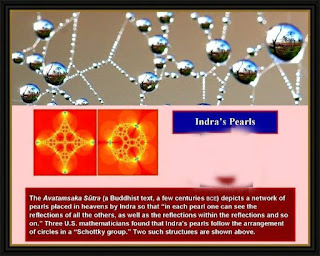Welcome to the world of IndraJaala
Indra's net (also called Indra's jewels or Indra's pearls- Indrajaal in Sanskrit) is a metaphor used to illustrate the concepts of emptiness.The concept of "Indra's net" has its philosophical roots in early proto-forms of Sāṃkhya in Buddhism.
The earliest reference to a net belonging to Indra is in the Atharva Veda (c. 1000 BCE) Verse 8.8.6. says:
Vast indeed is the tactical net of great Indra, mighty of action and tempestuous of great speed. By that net, O Indra, pounce upon all the enemies so that none of the enemies may escape the arrest and punishment. ||
And verse 8.8.8. says:
This great world is the power net of mighty Indra, greater than the great. By that Indra-net of boundless reach, I hold all those enemies with the dark cover of vision, mind and senses. ||
The net was one of the weapons of the sky-god Indra, used to snare and entangle enemies.The net also signifies magic or illusion.
According to Teun Goudriaan, Indra is conceived in the Rig Veda as a great magician, tricking his enemies with their own weapons, thereby continuing human life and prosperity on earth.Indra became associated with earthly magic, as reflected in the term indrajalam, "Indra's Net",.was characterized there as the antariksa-, the intermediate space between heaven and earth, while the directions of the sky were the net's sticks (dandah) by means of which it was fastened to the earth. With this net Indra conquered all his enemies.
Rajiv Malhotra uses the image of Indra's net as a metaphor for
the profound cosmology and outlook that permeates Hinduism. Indra's Net symbolizes the universe as a web of connections and interdependences [...] I seek to revive it as the foundation for Vedic cosmology and show how it went on to become the central principle of Buddhism, and from there spread into mainstream Western discourse across several disciplines
The earliest reference to a net belonging to Indra is in the Atharva Veda (c. 1000 BCE) Verse 8.8.6. says:
Vast indeed is the tactical net of great Indra, mighty of action and tempestuous of great speed. By that net, O Indra, pounce upon all the enemies so that none of the enemies may escape the arrest and punishment. ||
And verse 8.8.8. says:
This great world is the power net of mighty Indra, greater than the great. By that Indra-net of boundless reach, I hold all those enemies with the dark cover of vision, mind and senses. ||
The net was one of the weapons of the sky-god Indra, used to snare and entangle enemies.The net also signifies magic or illusion.
According to Teun Goudriaan, Indra is conceived in the Rig Veda as a great magician, tricking his enemies with their own weapons, thereby continuing human life and prosperity on earth.Indra became associated with earthly magic, as reflected in the term indrajalam, "Indra's Net",.was characterized there as the antariksa-, the intermediate space between heaven and earth, while the directions of the sky were the net's sticks (dandah) by means of which it was fastened to the earth. With this net Indra conquered all his enemies.
Rajiv Malhotra uses the image of Indra's net as a metaphor for
the profound cosmology and outlook that permeates Hinduism. Indra's Net symbolizes the universe as a web of connections and interdependences [...] I seek to revive it as the foundation for Vedic cosmology and show how it went on to become the central principle of Buddhism, and from there spread into mainstream Western discourse across several disciplines


